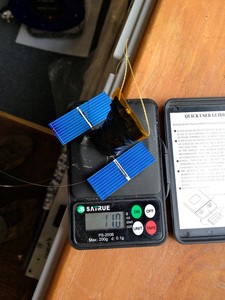Balloons Carrying Amateur Radio Payloads Still Circling the Earth
Aug 31st, 2014 | By Tom Reis NØVPR | Category: ChatterTweet
Three plastic foil-envelope balloons carrying Amateur Radio payloads and launched from the UK by Leo Bodnar, M0XER, remain aloft and continue to circle the Earth. The oldest, identified as B-63, was released on July 8 and became the second of Bodnar’s balloons to circumnavigate the globe. The first to do so, B-64, went up on July 12 and had completed one lap around the Northern Hemisphere by July 31. Air currents have carried the balloon within 9 km of the North Pole and within 10 km of its launch site. The last balloon to make it around the Earth was B-66, which Bodnar released on July 15.

| The B-64 solar-powered payload on a scale. [Leo Bodnar, M0XER, photo] |
Each balloon carries a tiny 10 mW solar-powered transmitter that can alternate between APRS and Contestia 64/1000 digital mode on 434.500 MHz (USB). The Amateur Radio payload weighs just 11 grams.
As of this week, the B-64 balloon (M0XER-4 on APRS) was north of Moscow, Russia, at an elevation of more than 40,200 feet; the B-63 balloon (M0XER-3 on APRS) appeared to be located nearly 42,000 feet above South Korea, and the B-66 balloon (M0XER-6 on APRS) appeared to be nearly 44,000 feet above Ukraine. Notes on the M0XER-3 and M0XER-6 APRS pages flag their reported trajectories with “Seriously bad path,” however, and add, “This station appears to be flying at high altitude and using digipeaters, which causes serious congestion in the APRS network. The tracker should be configured to only use digipeaters when at low altitude.”
The numeral following the “B” denotes the number of similar balloons Bodnar has launched (B-65 failed to deploy). The transmitter stores positions during its flight and transmits a log file that can recall 5 days of previous locations in the comments field of its APRS transmissions. If it has been out of radio contact, however, a straight line will appear on the APRS map.
